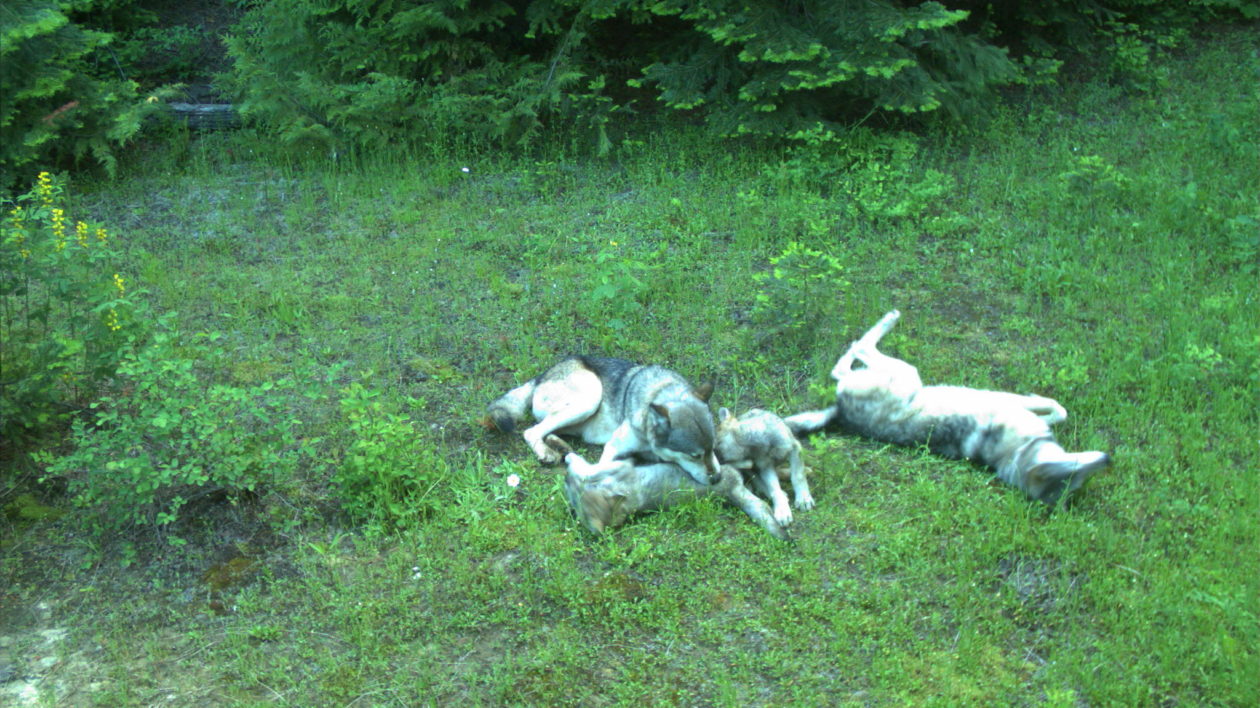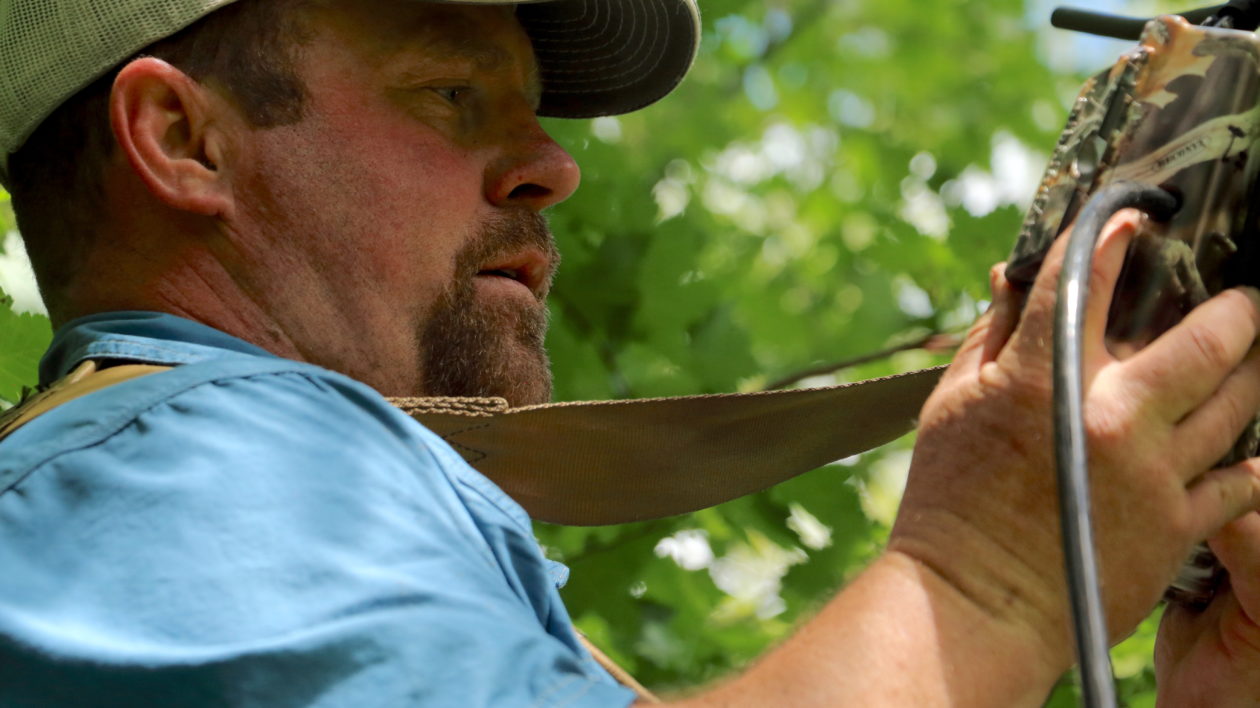Something’s wrong with the harness. As Josh Rydalch settles his weight into it, 8 feet up an evergreen, his head starts losing priority to his bottom half. There’s no way I’m letting him dangle upside down, at least not for long. I put down my camera, scramble up the rise and throw my weight onto his boots. The commanding shift brings his feet in contact with a limb before his face does. Rydalch, now upright again, starts strapping trail cam to trunk while explaining why he’s willing to go to such astonishing lengths for research.
“The goal is to monitor for wolves in the area, if there are wolves,” says Josh Rydalch, Idaho Department of Fish and Game wildlife biologist. “Hopefully we get wolves walking by and if a wolf walks by, that’s an occupied site.”
The way Rydalch counts occupied sites is changing. GPS collars, the most popular wildlife tracking tool in recent years, is losing reign. Electronically tagging an animal, be it finned, feathered or furred, requires manpower and money.
One GPS collar alone can cost up to $2,000. That doesn’t include scouting time to find the animal, labor to attach the collar or satellite service for collar location transmission. Trail cameras, the collar’s new competition, are $500 for a research-decent model. And attaching them requires tree touch instead of wild wrangle.
“This is a lot less invasive for the animal,” Rydalch says. “The animal is not in hand. It’s not being darted or trapped.”
Wolves, aggressively monitored via collar while on the Endangered Species List, were delisted in Idaho and Montana in 2011 and in Wyoming in 2012. During listing, federal money covered collaring costs. Those funds disappeared with delisting, but states still keep track of packs to ensure sustainable population growth. That’s why 200 trail cameras from Canada to Utah started capturing the Gem State in 2016 for a population study. Biologists are counting wolves with cameras instead of collars.
“As the wolf population grew, it became a ridiculous notion to think we could collar a wolf in every pack,” says David Ausband, Idaho Department of Fish and Game wildlife research biologist. “Any wolf collaring done now is for livestock issues. We don’t use collaring as a monitoring method anymore. It’s cameras.”

While Rydalch tracks pack population changes in eastern Idaho, Ausband is in charge of discovering the why behind population changes. He’s the trail cam ringleader for the whole state.
“If we see no wolves on a camera one year and half of the wolves on that camera the next year, something changed,” Ausband says.
Field time is changing too. Biologists, who chose their profession for its outdoor appeal, are finding themselves inside for weeks at a time instead of coming inside every now and then.
“Cameras certainly reduce your field effort because they’re surveying when you’re not there,” Ausband says. “But that’s a double-edged sword. It’s saving data when you’re not there, but it forces you to be in the office longer to go through the data.”
The unintentional result of unmanned monitoring is a pile of images that include sometimes nothing and other times everything but a wolf. Bears, bobcats, butterflies, buffoons.
“It’s amazing how many people walk by in the middle of nowhere on a trail. They see our cameras sometimes. Sometimes they give me good signals and wave and sometimes they’re not [good].”

But every shot is still worth analyzing. It can lead to proof of illegal OHV use. Or of even higher value, empty spots.
“Empty spots are probably our most important shot with trail cameras,” Ausband says. “If the population is going to expand or decrease, the area we’ll detect that in first isn’t the core, it’s the edges. The edges of the puddle dry first. Not the center.”
All population-counting trail cams have to be out in the field by July 1 and back in the office after September 30. Pack movement is limited during that summer window. Pups don’t go far and pups don’t know how to hunt. Adults leave their pups at rendezvous sites and come and go with food. Any other time of year, they can move a dozen miles a night. The cameras need to catch them before the constraint of raising young loosens. So far, the cam catch is working.
“We know we still have wolves widely distributed throughout Idaho,” Ausband says. “From here on out, it’s cameras for wolves. There’s interest in how many wolves we have and what the population is doing so I don’t see trail cams going away.”



I support the use of trail cameras as a less intrusive form of monitoring the movements of Idaho’s grey wolf population. I remain concerned about the attitudes and policies of the Idaho state government, including the Department of Fish & Game (aka Wildlife), regarding wolf re-introduction and the influence of hunters and livestock managers (especially on public lands) on sustainable wolf management. Livestock grazing on public lands negatively affects ecological health and competes directly with native wildlife. Depredation of livestock by wolves is minor compared to the numbers of livestock who die of natural causes, are hit by vehicles, are attacked by feral dogs, or other predators. Yet they remain the “villain” and excuse for livestock grazing excesses. The loss of livestock to wolves is what drove the effort to eliminate them from the lower 48 states in the first place. Essentially, livestock should be removed from public lands and allow natural wildlife to co-exist without the influence of exotic species that over graze the resource. There are many non-lethal means of separating wolves from livestock on private grazing lands that many ranchers are using with success (e.g., livestock guardian dogs, human range rovers, etc).
Hunting of wolves is a behavior that belongs in the 19th century not the 21st. To ” manage wolf populations so that wolf numbers will not adversely affect big game populations or the economic viability of those who depend on big game animals” (Idaho Wolf Population Management Plan
2008-2012) is obviously biased towards hunting interests. Wolves need to be free to hunt and feed themselves and their offspring without the risk of being shot by someone who is out for a “thrill” or just likes the sounds of firing a big rifle. Managing one wild population (wolves) to artificially increase other wildlife (big game) is not ecologically sound or truly sustainable (where is the morality in this policy?). I am aware of studies around Yellowstone National Park that have found that wolves do not adversely affect the number of big game available for hunters (its a myth).
Hopefully, as the 19th century attitudes about predators in general (humans being the apex predator of the planet) and wolves in particular will give way as the generations that hold these attitudes and influence wildlife management policy are replaced by a more enlightened generation that values nature and ecological balance. Again, hopefully this change in management philosophy occurs soon enough that existing wildlife species avoid extinction.
HELP THEM!!!!!!
Get rid of collars. They are used by wildlife services to track and kill wolves. Thank goodness for photo viewing.
Great discussion. We have been using cameras for determining use of livestock tanks by wildlife (1 year). Amazing the diversity of wildlife that drink, bathe, and hunt by these tanks. We have also spent a year assessing use of pinyon-juniper habitat in southeastern Colorado by wildlife — very remote and in good ecological condition. And now The Nature Conservancy in Colorado, Colorado Parks and Wildlife, the United States Geological Survey, Colorado State University, and the Colorado State Land Board are measuring any changes in bighorn sheep use from habitat treatments. Luckily (and due to the Colorado Parks and Wildlife, we have some satellite collars to double check our observations). It is amazing what moves into the views of wildlife cameras. Important science, good natural history, and nearly always inspiring!